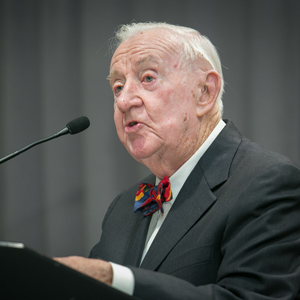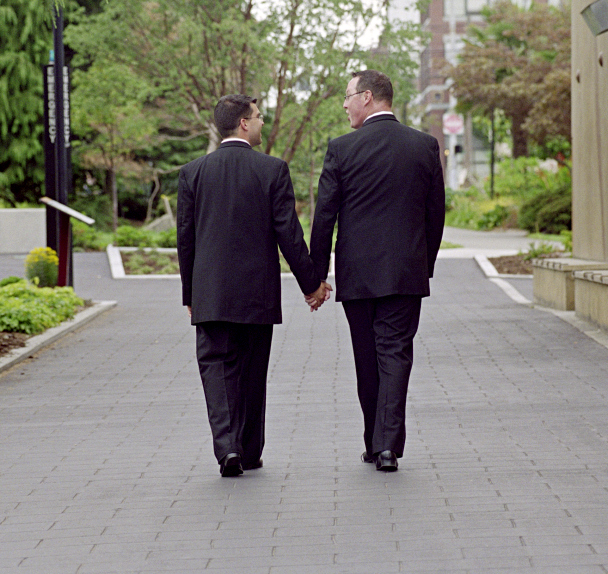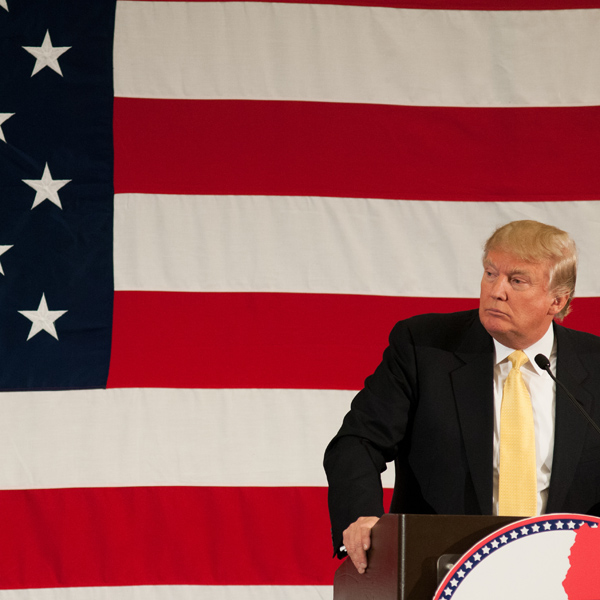Retired Justice John Paul Stevens dies at 99

Retired Justice John Paul Stevens called for a “national solution” to the death penalty at the 2015 ABA Annual Meeting. Photo by ©Kathy Anderson.
Retired Supreme Court Justice John Paul Stevens died Tuesday from complications from a stroke. He was 99 years old.
Stevens died at a Florida hospital nine years after his retirement. The New York Times, the Associated Press, the Wall Street Journal and the Washington Post have coverage. A press release is here.
Stevens was nominated to the Supreme Court by President Gerald Ford in 1975 and surprised some when he became leader of the court’s liberal bloc. He was the third-longest serving justice on the U.S. Supreme Court, according to the Washington Post.
ABA President Bob Carlson issued a statement expressing condolences and noting that Stevens was a frequent speaker at ABA meetings.
Stevens “had a brilliant and independent legal mind and exemplified the best characteristics of a jurist,” Carlson said. “From his service in the Navy during World War II for which he won the Bronze Star, to his clerkship for Supreme Court Justice Wiley Rutledge in 1947, to his tenure as a judge of the United States Court of Appeals for the 7th Circuit from 1970-75, Justice Stevens always stood up for justice and against corruption.”
Stevens’ recently published memoir is The Making of a Justice: Reflections on My First 94 Years.
Since his retirement, Stevens called for repeal of the Second Amendment, opposed the confirmation of then-Supreme Court nominee Brett Kavanaugh, and commented on what he believed to be the Supreme Court’s worst opinion during his 35 years on the court.
That case was District of Columbia v. Heller, the 2008 decision holding that the Second Amendment created an individual right to bear arms. Stevens was in the dissent.
Stevens had also expressed regret that he supported reinstatement of the death penalty in 1976. In 2011, the ABA’s Death Penalty Representation Project named an award in his honor—the John Paul Stevens Guiding Hand of Counsel Award. The annual award recognizes lawyers who have demonstrated the kind of courage and commitment associated with Stevens.
In a 2015 speech to the ABA, Stevens supported the Supreme Court decision establishing a right to gay marriage, Obergefell v. Hodges. “The right to marry—like the right to decide whether to have an abortion, or the right to control the education of your children—fits squarely within the category of liberty protected by the due process clause of the 14th Amendment,” Stevens said.
The Boston Globe and the ABA Journal listed many of Stevens’ notable opinions in prior articles. They included:
• Kelo v. City of New London (2005), which permitted the use of eminent domain for private development.
• Atkins v. Virginia (2002), which struck down the death penalty for mentally disabled criminals.
• Hamdan v. Rumsfeld (2006), which held President George W. Bush could not set up military commissions at Guantanamo Bay without congressional authority.
• Dissent in Bush v. Gore (2000), in which Stevens argued the Supreme Court’s decision paving the way for George W. Bush’s election had eroded confidence in independent judges.
• Dissent in Citizens United v. Federal Election Commission (2010), in which Stevens said the Supreme Court was repudiating common sense when it struck down restrictions that barred corporations from spending money on campaign ads.
• Dissent in Bowers v. Hardwick (1986), in which Stevens argued the Supreme Court wrongly upheld a Georgia law criminalizing sodomy. When the court later overturned the decision, Justice Anthony M. Kennedy wrote that Stevens was right.
Stevens described himself as “pretty darn conservative” in a 2007 New York Times interview. In his view, the court was shifting right, making him appear more liberal. During a speech at the 2015 ABA Annual Meeting, Stevens praised Chief Justice John G. Roberts Jr., saying, “I respect his work even though I often disagree with his views.”
In a speech in 2010, Stevens explained why he wore his trademark bow ties. “The truth is I can’t tie a four in hand,” he said, referring to the knot on the more commonly worn tie.
See Also:
ABA Journal (2010): “Man of Moderation: Last Justice of ‘Greatest Generation,’ Says Farewell”
ABA Journal (2010): “Practical Meaning: As the Court Shifted Right, Stevens Kept His Place”
Photo Gallery: Justice John Paul Stevens’ 10 Most Influential Cases
Photo Gallery: The Childhood of Justice John Paul Stevens




